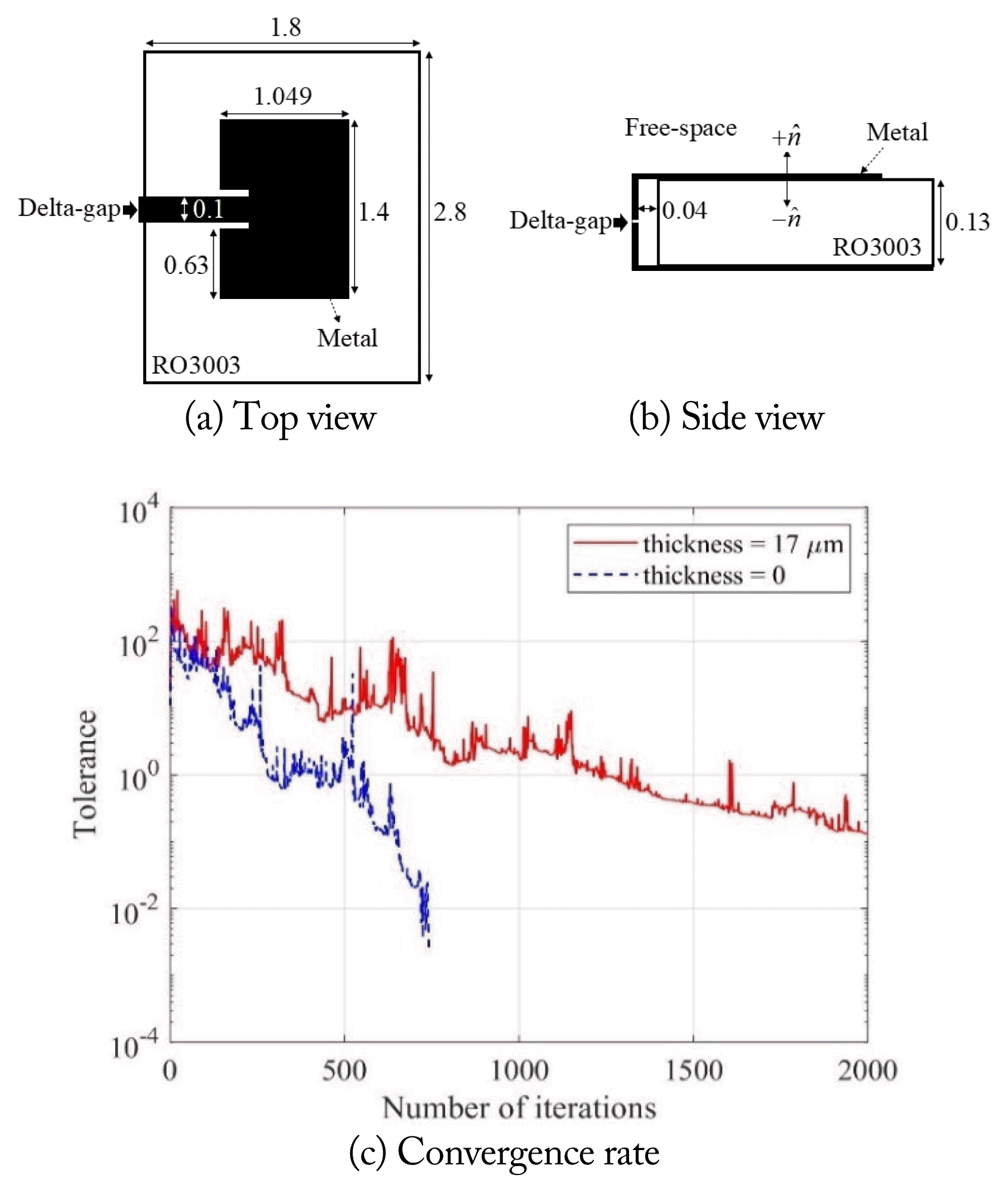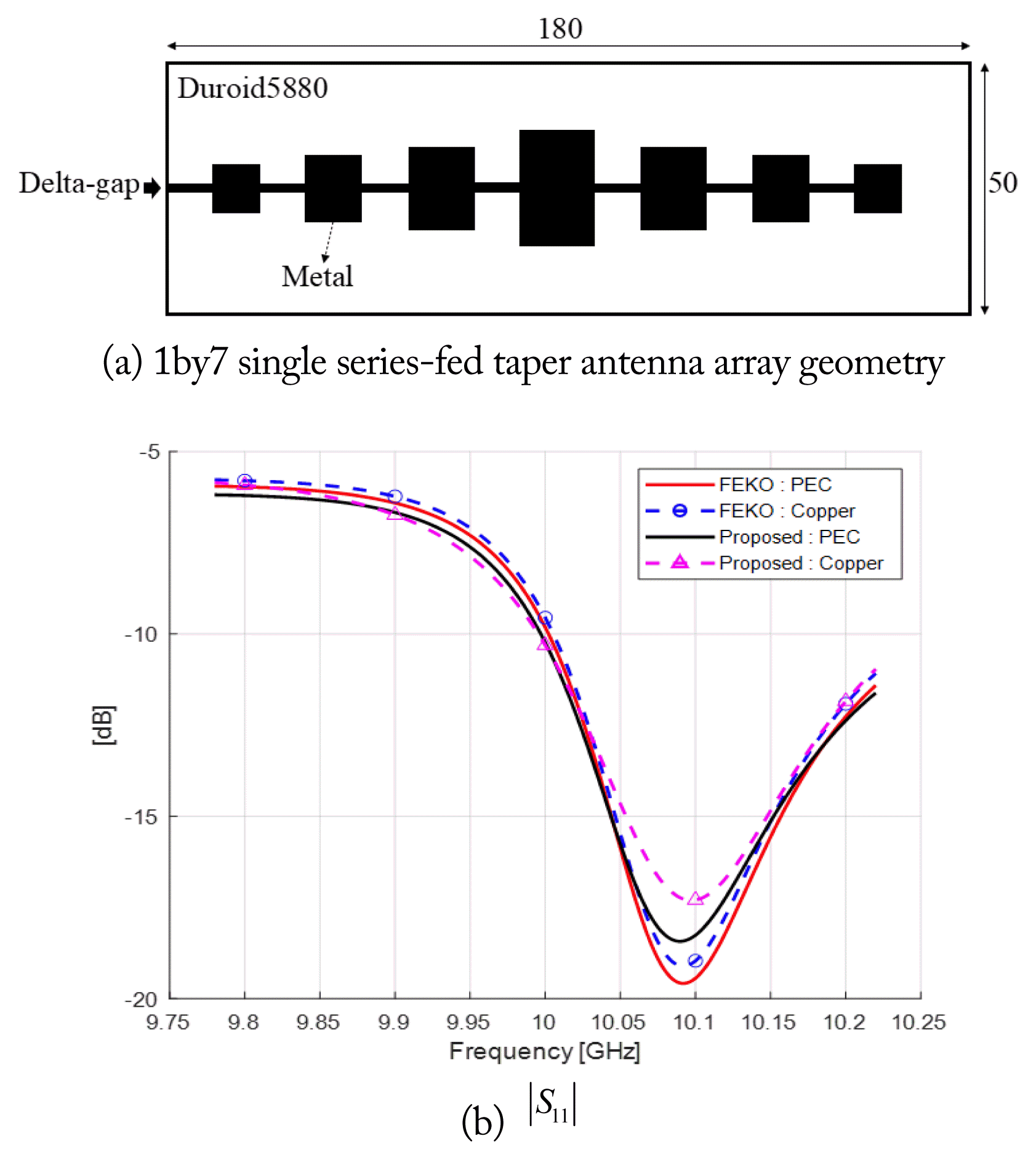I. Introduction
Various numerical methods have been used to analyze microstrip antennas, such as the method of moments (MoM) and the finite element method (FEM) [1, 2]. The accuracy and convergence properties of the methods can deteriorate in a thin imperfect conductor (lossy metal). Therefore, the metal is usually assumed to be a perfect electrical conductor (PEC) with zero thickness. It can be efficiently modeled by the electric field integral equation (EFIE) [1]. A resistive (impedance) sheet model is used for a lossy metal, but its accuracy may not be satisfactory [2].
In general, the impedance boundary condition (IBC) may be more accurate for lossy metal with a wide range of conductivity than the resistive sheet model. The combined field integral equation (CFIE) for the IBC is given by:
The parameters in Eq. (1) are found in a previous study [3]. Due to the K-operator in Eq. (1), the IBC surface should be closed. Therefore, the zero-thickness lossy metal cannot be analyzed based on the IBC. We proposed a technique for a zero-thickness lossy metal based on the complete IBC formula in Eq. (1). We compared the proposed scheme with two commercial tools, FEKO and HFSS, in terms of the scattering parameter (|S11|), directivity (D), gain (G), and efficiency (eff.) of a microstrip antenna consisting of lossy metal.
II. Zero-Thickness Impedance Plate
The feeding source is modeled by the delta gap [1]. E → H → E → H →
When the thickness (t) of the metal becomes zero, mesh 1 and mesh 2 on the opposite surfaces coincide with each other, as shown in Fig. 1. The opposite meshes facing the free-space and dielectric can be separately assembled. In addition, due to the non-penetrating properties of the IBC, no direct interactions happen among the meshes on the opposite surfaces. Therefore, strong direct interactions can be avoided. As a result, the zero-thickness IBC surface is closed, and the K-operator in Eq. (1) can be calculated exactly.
We considered a PEC antenna (η = 0) made with very thin metal (17 or 0 μm thick). The antenna geometry is shown in Fig. 2(a); the units are in millimeter, and it operates at 76 GHz. The dielectric substrate is RO3003, which has a dielectric constant and loss tangent of 3.0 and 0.0013, respectively. The reference impedance is assumed to be 50Ω. The delta gap port has a separation of 40 μm from the substrate, as shown in Fig. 2(b) [4]. Table 1 shows a comparison of the results of the proposed IBC formula and FEKO, which have excellent agreement for the zero-thickness case. Fig. 2(c) shows the convergence rate of the IBC formula. The low thickness can generate strong interactions on the metal surface. Therefore, the convergence stagnates. But zero thickness can prevent strong interactions, as explained earlier, resulting in fast convergence. Hence, the results for the 0 μm case agree well with those of FEKO, but do not for the 17-μm case.
For a larger structure, a 1-by-7 single-series-fed antenna is considered and operates at 10.1 GHz. It consists of PEC or copper plates with zero thickness. The detailed dimensions of the antenna can be found in another study [5]. The conductivity (σ) of the copper is 5.96 × 107 [S/m] [6]. The substrate of the antenna is Duroid5880, which has a dielectric constant and loss tangent of 2.2 and 0.0009, respectively. When the metal thickness is greater than the skin depth, the normalized impedance is calculated as
η = π f ε 0 / σ · ( 1 + j )
We investigated the effect of the conductivity on the final antenna simulation accuracy by considering the conductivities of several lossy metals, of which the type, and conductivity are given in [6]. The conductivity range includes that of the transparent conductor indium tin oxide (ITO), σ ≈1.3×106. The antenna in Fig. 2(a) is considered.
FEM can provide more accurate results for this kind of lossy conductor. Therefore, the results of HFSS were also compared. Fig. 4 shows |S11| and efficiency at 76 GHz, and for a clear comparison, the results of σ =1×108 and PEC are added. The PEC current can be used to estimate the absorbed power by the imperfect conductor, based on which the efficiency and |S11| can be modified [7]. This approximation, the proposed scheme, HFSS and FEKO results are compared in Fig. 4. In the FEKO simulation, the conductor is modeled by the impedance sheet. The accuracy of the proposed scheme is far over the whole conductivity range. For high conductivities, the results of FEKO and the proposed scheme are very similar, but slightly different from that of HFSS, because of the usage of different port models and the delta gap being located slightly away from the substrate in Fig. 2(b).
III. Conclusion
A MoM scheme was proposed to deal with zero-thickness lossy metal based on the IBC and was applied to the analysis of a microstrip antenna. A lossy metal can usually be modeled by the IBC, so the advantage of the proposed scheme can provide more accurate results over a wide range of conductivity, which was numerically verified by comparing the results of the proposed scheme, FEKO, and HFSS. However, the major disadvantage of the proposed scheme is that the number of meshes increases, because meshes are required for the closed IBC metal, resulting in more memory required and computation time.












